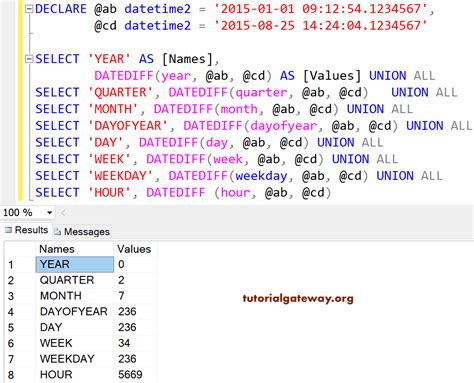Spark SQL provides a robust set of functions for manipulating and analyzing data, including the Datediff function. The Datediff function is used to calculate the difference between two dates in days. In this article, we will explore the usage and syntax of the Datediff function in Spark SQL, along with examples and use cases.
Key Points
- The Datediff function calculates the difference between two dates in days.
- The function takes two arguments: the start date and the end date.
- The start date and end date can be specified using the date, timestamp, or string data types.
- The function returns the difference between the two dates in days as an integer value.
- The Datediff function is commonly used in data analysis and reporting to calculate time intervals and durations.
Syntax and Usage

The syntax of the Datediff function in Spark SQL is as follows:
datediff(endDate, startDate)
Where:
- endDate: the end date of the interval
- startDate: the start date of the interval
The Datediff function can be used in Spark SQL queries, such as:
SELECT datediff(date2, date1) AS diff FROM table;
This query calculates the difference between the dates in the date2 and date1 columns and returns the result as a new column named diff.
Examples
Here are some examples of using the Datediff function in Spark SQL:
// Example 1: Calculate the difference between two dates
val df = spark.createDataFrame(Seq(
(1, "2022-01-01", "2022-01-15")
)).toDF("id", "start_date", "end_date")
df.select(datediff(col("end_date"), col("start_date")).alias("diff")).show()
// Output:
// +----+
// |diff|
// +----+
// | 14|
// +----+
// Example 2: Calculate the difference between two timestamps
val df2 = spark.createDataFrame(Seq(
(1, "2022-01-01 12:00:00", "2022-01-15 12:00:00")
)).toDF("id", "start_timestamp", "end_timestamp")
df2.select(datediff(col("end_timestamp"), col("start_timestamp")).alias("diff")).show()
// Output:
// +----+
// |diff|
// +----+
// | 14|
// +----+
In these examples, the Datediff function is used to calculate the difference between two dates or timestamps in days.
Use Cases

The Datediff function has several use cases in data analysis and reporting, such as:
- Calculating time intervals: The Datediff function can be used to calculate the time interval between two dates or timestamps.
- Calculating durations: The Datediff function can be used to calculate the duration of an event or a process.
- Data filtering: The Datediff function can be used to filter data based on a specific time interval or duration.
- Data aggregation: The Datediff function can be used to aggregate data based on a specific time interval or duration.
For example, in a sales database, the Datediff function can be used to calculate the time interval between the order date and the delivery date, or to calculate the duration of a sales promotion.
Best Practices
Here are some best practices to keep in mind when using the Datediff function:
- Ensure that the start date and end date are in the correct format.
- Use the correct data type for the start date and end date columns.
- Be aware of the time zone differences when working with dates and timestamps.
- Use the Datediff function in combination with other functions, such as the Date_add and Date_sub functions, to perform more complex date calculations.
| Function | Description |
|---|---|
| Date_add | Adds a specified number of days to a date. |
| Date_sub | Subtracts a specified number of days from a date. |
| Datediff | Calculates the difference between two dates in days. |

In conclusion, the Datediff function is a useful function in Spark SQL that can be used to calculate the difference between two dates in days. By following the best practices and using the function in combination with other date and time functions, you can perform complex date calculations and gain valuable insights from your data.
What is the syntax of the Datediff function in Spark SQL?
+The syntax of the Datediff function in Spark SQL is datediff(endDate, startDate), where endDate is the end date of the interval and startDate is the start date of the interval.
What is the return type of the Datediff function?
+The return type of the Datediff function is an integer value representing the difference between the two dates in days.
Can the Datediff function be used with timestamps?
+Yes, the Datediff function can be used with timestamps. The function will calculate the difference between the two timestamps in days.



